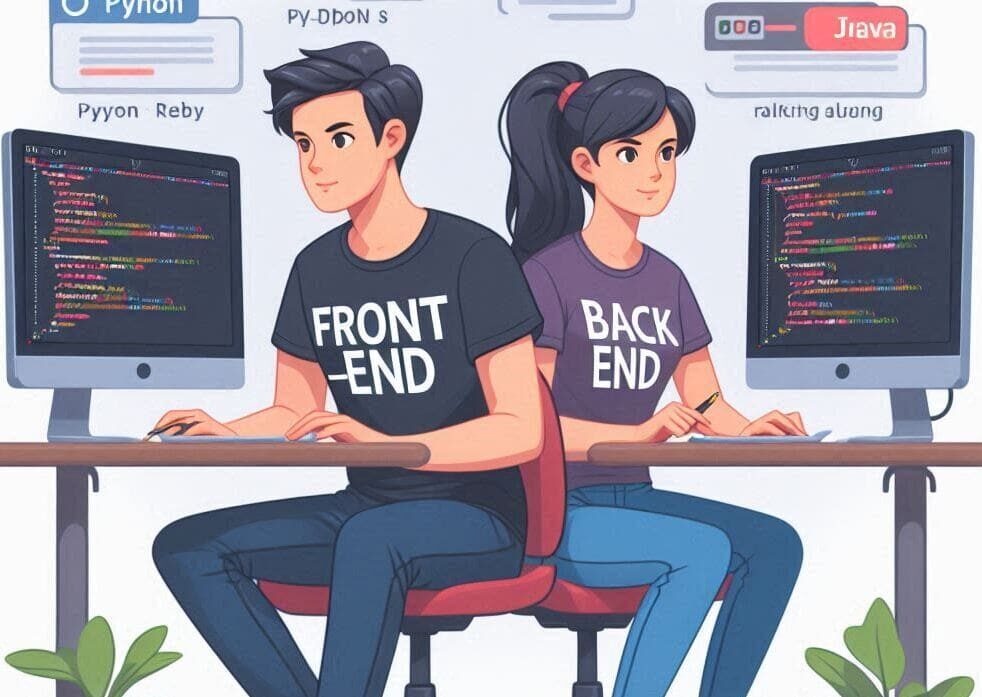When you start learning about web development, you’ll often hear the terms “front-end” and “back-end.” These two parts are important for creating a fully functional website or web app. But what do they really mean, and how are they different? Let’s break down the basics of front-end vs. back-end development to better understand their roles.
1. What is front-end development?
Front-end development is all about the parts of a website that users see and interact with directly. It’s about making sure the website looks good and works well.
Key Technologies:
- HTML (HyperText Markup Language): This is the structure of the website.
- CSS (Cascading Style Sheets): This styles the website, making it look nice.
- JavaScript: This makes the website interactive and fun to use.
Role of a Front-End Developer: Front-end developers design and build the layout, design, and interactive parts of a website. They work closely with designers to make sure everything looks great and is easy to use.
2. What is back-end development?
Back-end development deals with what happens behind the scenes. It’s about managing the server, database, and application logic.
Key Technologies:
- Server-side languages: Such as Python, Ruby, Java, PHP, and Node.js.
- Databases: Including MySQL, PostgreSQL, MongoDB, and SQLite.
- Server management: Tools and services like Apache, Nginx, and cloud platforms like AWS, Azure, or Google Cloud.
Role of a Back-End Developer: Back-end developers handle the server, database, and application logic. They make sure that everything runs smoothly behind the scenes, processing user requests and managing data.
3. Difference Between Front-End vs Back-End
- User Interaction:
- Front-End: Directly interacts with users, focusing on the user experience.
- Back-End: Works behind the scenes, ensuring the smooth operation of applications and processing user requests.
- Technologies Used:
- Front-End: HTML, CSS, JavaScript, and frameworks like React, Angular, or Vue.js.
- Back-End: server-side languages, databases, and frameworks like Express.js, Django, or Ruby on Rails.
- Focus Area:
- Front-End: visual design, user interface, and client-side scripting.
- Back-End: server logic, database management, and server-side scripting.
4. Front-End Frameworks and Libraries
React: A JavaScript library for building user interfaces, developed by Facebook.
Angular: A TypeScript-based framework developed by Google for building dynamic web applications.
Vue.js: A dynamic framework for building user interfaces, known for its simplicity and flexibility.
5. Back-End Frameworks and Libraries
Express.js: A minimal and flexible Node.js web application framework that provides a robust set of features for web and mobile applications.
Django: A high-level Python web framework that encourages rapid development and clean, pragmatic design.
Ruby on Rails: A server-side web application framework written in Ruby under the MIT License, emphasizing convention over configuration (CoC).
6. Career Paths in Front-End and Back-End Development
1. Front-End Developer:
- Skills Required: Proficiency in HTML, CSS, JavaScript, and knowledge of front-end frameworks.
- Job Role: Building responsive websites, improving user experience, collaborating with designers.
2. Back-End Developer:
- Skills Required: Knowledge of server-side programming languages, database management, and server architecture.
- Job Role: Developing and maintaining web applications, ensuring database integrity, handling server-side logic.
7. Full-Stack Development
Full-Stack developers are flexible professionals who have expertise in both front-end and back-end development. They can handle the complete development process, from designing user interfaces to managing databases and servers.
Skills Required:
- Front-End: Proficiency in HTML, CSS, JavaScript, and related frameworks.
- Back-End: Proficiency in server-side languages, database management, and server configuration.
Role of a Full-Stack Developer: Full-stack developers have a large skill set that allows them to work on both client-side and server-side parts of an application. This flexibility makes them valuable for small teams and startups where resources might be limited.
8. Conclusion
Understanding the differences between front-end and back-end development is important for anyone looking to enter the field of web development. While front-end development focuses on the user interface and experience, back-end development ensures that the server, database, and application logic are all functioning smoothly. Both roles are important, and mastering one or both can lead to a rewarding career in the tech industry.
Whether you choose to specialise in front-end, back-end, or become a full-stack developer, each path offers unique challenges and opportunities. As the tech industry continues to grow, the demand for skilled developers in all areas remains high, making it a promising career choice for the future.
FAQs
1. What is the main difference between front-end and back-end development?
The main difference lies in what each focuses on. Front-end development is about creating the parts of a website or application that users interact with directly. This includes the design, layout, and interactivity. Back-end development, on the other hand, deals with server-side operations, database management, and application logic, ensuring that everything runs smoothly behind the scenes.
2. Which programming languages are commonly used in front-end development?
Common programming languages and technologies used in front-end development include HTML, CSS, and JavaScript. Additionally, developers often use frameworks and libraries like React, Angular, and Vue.js to streamline the development process and create more dynamic user interfaces.
3. What skills are essential for a back-end developer?
A back-end developer should be proficient in server-side programming languages such as Python, Ruby, Java, PHP, or Node.js. They should also be skilled in managing databases like MySQL, PostgreSQL, MongoDB, and understanding server architecture and configuration. Knowledge of frameworks like Express.js, Django, or Ruby on Rails is also beneficial.
4. Can someone be both a front-end and back-end developer?
Yes, someone who is skilled in both front-end and back-end development is known as a full-stack developer. Full-stack developers have a comprehensive understanding of both client-side and server-side technologies, allowing them to handle the complete development process from start to finish.




